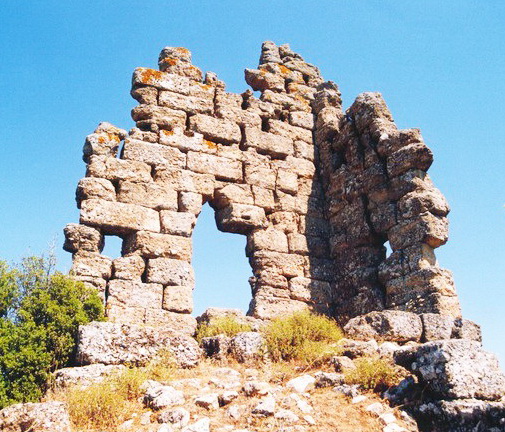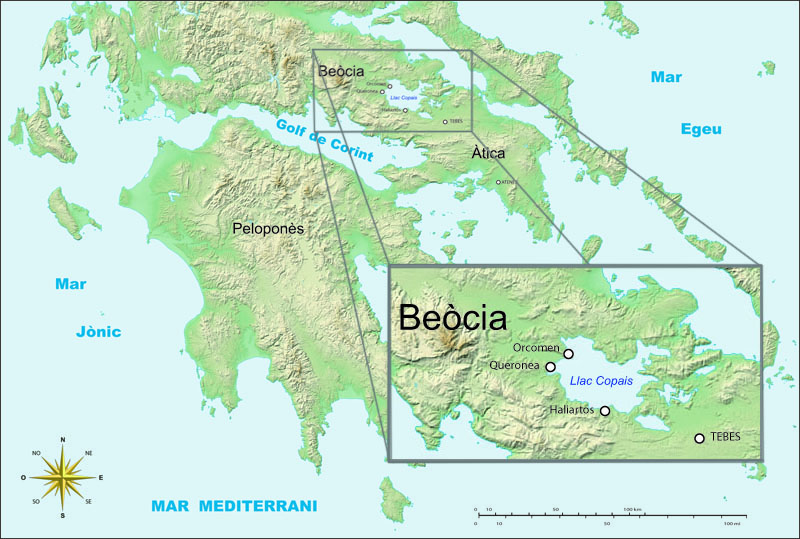|
Cyrtones
Cyrtones or Kyrtones (), anciently called Cyrtone or Kyrtone (Κυρτώνη), was a city of Boeotia, east of the Lake Copais, and 20 stadia from Hyettus, situated upon a lofty mountain, after crossing which the traveller arrived at Corsia. Cyrtones contained a grove and temple of Apollo, in which were statues of Apollo and Artemis In ancient Greek religion and Greek mythology, mythology, Artemis (; ) is the goddess of the hunting, hunt, the wilderness, wild animals, transitions, nature, vegetation, childbirth, Kourotrophos, care of children, and chastity. In later tim ..., and a fountain of cold water, at the source of which was a chapel of the nymphs. The site of Cyrtones is tentatively located at Kastron Kolakas/Karaouli, near the modern village of Kyrtoni, which was renamed from Kolaka to reflect association with the ancient town. The remains of a walled enclosure, and of a building, possibly a temple, have been found. This ancient fortification has a square tower mad ... [...More Info...] [...Related Items...] OR: [Wikipedia] [Google] [Baidu] |
Kyrtoni
Kyrtoni (, before 1987: Κολάκα - ''Kolaka'') is a village in the southeastern part of Phthiotis, Greece. It is part of the municipality of Lokroi since 2010. It was an independent commune between the 1820s and 1907, and was part the municipality of Atalanti between 1907 and 2010. In 2021 its population was 348. It is situated at 480 m elevation on the southern slope of the Chlomo mountain. It is 8 km southeast of Atalanti and 12 km northeast of Orchomenos. Its main industry is agriculture. The village takes its name from the ancient town Cyrtone. History The area around Kyrtoni was already inhabited during the Neolithic era (7000-3200/3100 BC). The name of the Neolithic settlement is unknown. There was also activity around Kyrtoni during the Archaic period (800-480 BC). The main occupations of the inhabitants were agriculture, animal husbandry and pottery. In the 2nd century CE, Pausanias described Cyrtones, also Cyrtone, as a town of ancient Boeotia situat ... [...More Info...] [...Related Items...] OR: [Wikipedia] [Google] [Baidu] |
Corseia
Corseia or Korseia (), or Chorsia (Χορσία), was town of ancient Boeotia, sometimes included in Opuntian Locris, was the first place which the traveller reached after crossing the mountains from Cyrtones. In the Third Sacred War it was taken by the Phocians, along with Orchomenus and Coroneia. In the plain below, the river Platanius joined the sea. When Pausanias visited in the 2nd century, he found a sacred grove of yews with a small image of Hermes Hermes (; ) is an Olympian deity in ancient Greek religion and mythology considered the herald of the gods. He is also widely considered the protector of human heralds, travelers, thieves, merchants, and orators. He is able to move quic ... in the open air, half a stadion from Corseia. Corseia's site is located near the modern Neochori. There are remains of the walled enclosure and three towers that have been studied by John M. Fossey. References Populated places in ancient Boeotia Populated places ... [...More Info...] [...Related Items...] OR: [Wikipedia] [Google] [Baidu] |
Ancient Boeotia
Boeotia ( ), sometimes Latinisation of names, Latinized as Boiotia or Beotia (; modern Greek, modern: ; ancient Greek, ancient: ), is one of the regional units of Greece. It is part of the modern regions of Greece, region of Central Greece (administrative region), Central Greece. Its capital is Livadeia, and its largest city is Thebes, Greece, Thebes. Boeotia was also a region of ancient Greece, from before the 6th century BC. Geography Boeotia lies to the north of the eastern part of the Gulf of Corinth. It also has a short coastline on the Gulf of Euboea. It bordered on Megaris (now West Attica) in the south, Attica in the southeast, Euboea in the northeast, Opuntian Locris (now part of Phthiotis) in the north and Phocis in the west. The main mountain ranges of Boeotia are Mount Parnassus in the west, Mount Helicon in the southwest, Cithaeron in the south and Parnitha in the east. Its longest river, the Cephissus (Boeotia), Cephissus, flows in the central part, where most of ... [...More Info...] [...Related Items...] OR: [Wikipedia] [Google] [Baidu] |
Lake Copais
Lake Copais, also spelled Kopais or Kopaida (; ), was a lake in the centre of Boeotia, Greece, west of Thebes. It was first drained in the Bronze Age, and drained again in the late 19th century. It is now flat dry land and is still known as Kopaida. A one-time island in the lake was modified in ancient times into a megalithic citadel, now called Gla. Lake Copais is also featured in Ubisoft's Assassin's Creed Odyssey (2018). Drainage When the lake existed, the towns of Haliartus, Orchomenus, and Chaeronea were on its shores. Rivers feeding the lake included the Cephissus, Termessus and Triton. The lake was (and is) surrounded by fertile land, but the lake increasingly encroached on the surrounding land because of inadequate drainage. First, though abortive, plans to drain the lake were made in 1834-1838. In 1865 a French company, Montferrier and Bonnair, signed a contract with the Greek government to drain the lake. But in 1873 after having drained the lake partially, th ... [...More Info...] [...Related Items...] OR: [Wikipedia] [Google] [Baidu] |
Stadion (unit)
The stadion (plural stadia, ; latinized as stadium), also anglicized as stade, was an ancient Greek unit of length, consisting of 600 Ancient Greek feet ('' podes''). Its exact length is unknown today; historians estimate it at between 150 m and 210 m. Calculations According to Herodotus, one stadium was equal to 600 Greek feet (''podes''). However, the length of the foot varied in different parts of the Greek world, and the length of the stadion has been the subject of argument and hypothesis for hundreds of years. An empirical determination of the length of the stadion was made by Lev Vasilevich Firsov, who compared 81 distances given by Eratosthenes and Strabo with the straight-line distances measured by modern methods, and averaged the results. He obtained a result of about . Various equivalent lengths have been proposed, and some have been named. Among them are: Which measure of the stadion is used can affect the interpretation of ancient texts. For example, the ... [...More Info...] [...Related Items...] OR: [Wikipedia] [Google] [Baidu] |
Hyettus
In Greek mythology, Hyettus ( - ''Hyettos'') was a native of Argos thought to have been the first man ever to have exacted vengeance over adultery: he reputedly killed Molurus, whom he had caught with his wife, and was sent into exile. King Orchomenus of Boeotia Boeotia ( ), sometimes Latinisation of names, Latinized as Boiotia or Beotia (; modern Greek, modern: ; ancient Greek, ancient: ), is one of the regional units of Greece. It is part of the modern regions of Greece, region of Central Greece (adm ... received him hospitably and assigned to him some land, where the village Hyettus was subsequently founded and named after him. Stephanus of Byzantium s. v. Ὕηττος Notes Mythology of Argos, Peloponnese Boeotian mythology Sexual fidelity References * Pausanias, ''Description of Greece'' with an English Translation by W.H.S. Jones, Litt.D., and H.A. Ormerod, M.A., in 4 Volumes. Cambridge, MA, Harvard University Press; London, William Heinemann Ltd. 1918. Onl ... [...More Info...] [...Related Items...] OR: [Wikipedia] [Google] [Baidu] |
Apollo
Apollo is one of the Twelve Olympians, Olympian deities in Ancient Greek religion, ancient Greek and Ancient Roman religion, Roman religion and Greek mythology, Greek and Roman mythology. Apollo has been recognized as a god of archery, music and dance, truth and prophecy, healing and diseases, the Sun and light, poetry, and more. One of the most important and complex of the Greek gods, he is the son of Zeus and Leto, and the twin brother of Artemis, goddess of the hunt. He is considered to be the most beautiful god and is represented as the ideal of the ''kouros'' (ephebe, or a beardless, athletic youth). Apollo is known in Greek-influenced Etruscan mythology as ''Apulu''. As the patron deity of Delphi (''Apollo Pythios''), Apollo is an oracular god—the prophetic deity of the Pythia, Delphic Oracle and also the deity of ritual purification. His oracles were often consulted for guidance in various matters. He was in general seen as the god who affords help and wards off e ... [...More Info...] [...Related Items...] OR: [Wikipedia] [Google] [Baidu] |
Artemis
In ancient Greek religion and Greek mythology, mythology, Artemis (; ) is the goddess of the hunting, hunt, the wilderness, wild animals, transitions, nature, vegetation, childbirth, Kourotrophos, care of children, and chastity. In later times, she was identified with Selene, the Lunar deity, personification of the Moon.Smiths.v. Artemis/ref> She was often said to roam the forests and mountains, attended by her entourage of nymphs. The goddess Diana (mythology), Diana is her Religion in ancient Rome, Roman equivalent. In Greek tradition, Artemis is the daughter of Zeus and Leto, and twin sister of Apollo. In most accounts, the twins are the products of an extramarital liaison. For this, Zeus' wife Hera forbade Leto from giving birth anywhere on solid land. Only the island of Delos gave refuge to Leto, allowing her to give birth to her children. In one account, Artemis is born first and then proceeds to assist Leto in the birth of the second twin, Apollo. Artemis was a kouro ... [...More Info...] [...Related Items...] OR: [Wikipedia] [Google] [Baidu] |
Cities In Ancient Boeotia
A city is a human settlement of a substantial size. The term "city" has different meanings around the world and in some places the settlement can be very small. Even where the term is limited to larger settlements, there is no universally agreed definition of the lower boundary for their size. In a narrower sense, a city can be defined as a permanent and Urban density, densely populated place with administratively defined boundaries whose members work primarily on non-agricultural tasks. Cities generally have extensive systems for housing, transportation, sanitation, Public utilities, utilities, land use, Manufacturing, production of goods, and communication. Their density facilitates interaction between people, government organisations, government organizations, and businesses, sometimes benefiting different parties in the process, such as improving the efficiency of goods and service distribution. Historically, city dwellers have been a small proportion of humanity overall, bu ... [...More Info...] [...Related Items...] OR: [Wikipedia] [Google] [Baidu] |




